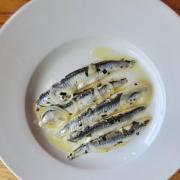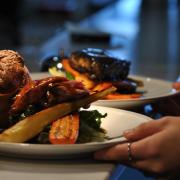Rick Stein’s latest cookbook, Food Stories, is made up of recipes inspired by his travels around the UK for the BBC show of the same name, discovering global cuisine right on our doorstep.

Rick Stein’s tattie scones with smoked salmon and beetroot
Try this for something different for lunch.
“I thought that potato cakes, or tattie scones as they’re known in Scotland, would be great served with excellent smoked salmon from the Isle of Bute and they certainly are,” says Rick Stein.
“They do need to be made with freshly cooked mashed potato, as the mixture is more malleable.”
Tattie scones with smoked salmon and beetroot, radish and fennel salad
Ingredients:
(Serves 4)
For the tattie scones:
500g floury potatoes, such as Maris Pipers or King Edwards, peeled
25g butter
2 spring onions, finely sliced
100-150g self-raising flour
Salt and black pepper
For the beetroot salad:
1 small raw beetroot, peeled
4 radishes, trimmed
1 small fennel bulb
2tbsp cider vinegar
1tbsp olive oil
1 heaped tsp brown soft sugar
1tsp chopped dill
To serve:
4tbsp crème fraiche
2 heaped tsp creamed horseradish
150-200g smoked salmon or trout
Extra dill or fennel fronds
Lemon wedges
Method:
1. Cut the potatoes into chunks, then put them in a pan of well-salted water (one teaspoon of salt per 600 millilitres) and cook until tender.
2. Drain and leave to dry for a minute or so. Mash until lump free, then stir in the butter and when it has melted, stir in the spring onions and enough flour to make a non-sticky dough. Season with salt and pepper, then leave until it’s cool enough to handle.
3. Put half of the mixture on a floured board and roll it into a disc about 20-25 centimetres in diameter – cut around a plate to help you make a neat round. Cut this into quarters and, using a fish slice, transfer these to a dry frying pan over a medium heat – the idea is to toast the scones rather than fry them. Cook for three to four minutes on each side until golden, then remove and keep warm. Repeat with the remaining mixture.
4. While the scones are cooking, finely slice each vegetable for the salad separately, preferably on a mandolin. Put them in a bowl, mix gently and dress with the cider vinegar, oil, sugar and chopped dill.
5. In a separate bowl combine the crème fraiche and horseradish, then season with salt and pepper.
6. Serve two tattie scones on each plate, top with the salad and a dollop of the crème fraiche mixture. Add slices of smoked salmon or trout, a few fronds of dill or fennel and some lemon wedges.

Rick Stein’s cheese, potato and spinach filo pie
A comforting pie for autumn nights.
“I wrote this recipe for a Greek-style filo pie after going to Mary Quicke’s farm and dairy near Exeter,” says Rick Stein. “It was a thoroughly enjoyable visit and I was very impressed with Mary’s resistance to automation, favouring the manual skills of her very experienced team. Very laudable when you consider the enormous popularity of her Cheddar cheese.”
He suggests using a vegetarian cheese called Double Devonshire for this pie.
Cheese, potato and spinach filo pie
Ingredients:
(Serves 6)
600g potatoes, peeled
260g spinach, washed
25g butter
1 large onion, sliced
175ml double cream
2 medium eggs, beaten
½-1tsp English or Dijon mustard
7-8 sheets of filo pastry
50g butter, melted
175g mature or vintage vegetarian Cheddar or Quicke’s Double Devonshire, coarsely grated
Salt and black pepper
Method:
1. Cook the potatoes in a pan of well-salted water (one teaspoon of salt per 600 millilitres), then drain and leave to cool. Cut them into slices five to six millimetres-thick. Wilt the spinach in a pan, then squeeze out as much of the liquid as possible.
2. Heat the butter in a pan, add the onion and fry until soft and golden. Mix the cream with the eggs and mustard, and season with black pepper.
3. Preheat the oven to 210°C/Fan 190°C. Take a 23-25 centimetre pie dish and layer four sheets of filo in the base, brushing each sheet with melted butter and alternating directions. Allow the excess to overhang the sides. Add half the sliced potato, scatter over some onion and spinach, then add half the cream mixture and cheese.
4. Season with salt and pepper. Repeat with the remaining potato, spinach and onion, season again with salt and black pepper and top with remaining cream and cheese.
5. Fold over the overhanging filo and then top with a further three or four sheets of filo, again brushing each one with melted butter. Brush the top of the pie with butter.
6. Bake for 10 minutes in the preheated oven, then cover the top with a sheet of foil to prevent it burning. Turn the oven down to 190°C/Fan 170°C and cook for a further 20-25 minutes. Leave to cool in the tin for five to 10 minutes before serving.

Rick Stein’s caramelised bread and butter pudding
It’s pudding season – and this is perfect for cold weekends.
“For me, bread and butter is a favourite nursery pudding,” says Rick Stein. “It was originally intended to use up stale bread, and with that thought in mind, I think that simple white bread is the right choice for this recipe.
“Some people choose brioche or some other enriched dough, but I prefer the simple plainness of the bread with the creamy vanilla voluptuousness of the custard.
“I like to add some sultanas or candied peel or both to my bread and butter pudding, and finish it with an apricot glaze, having first caramelised the top with icing sugar under the grill.”
Caramelised bread and butter pudding with sultanas and apricot glaze
Ingredients:
(Serves 6-8)
50g butter, plus extra for greasing
6-7 thin slices of white bread, crusts removed
100g sultanas or candied peel, or a mixture
250ml double cream
250ml whole milk
3 medium eggs
50g caster sugar
1 vanilla pod
25g icing sugar
25g apricot jam, warmed and sieved
To serve:
Clotted cream (optional)
Method:
1. Preheat the oven to 190°C/Fan 170°C. Butter a one-and-a-half-litre shallow ovenproof dish – something about six centimetres-deep is ideal.
2. Generously spread the slices of bread with butter and cut each slice into four triangles. Arrange a layer of the bread over the base of the dish, then sprinkle in the sultanas and/or candied peel. Arrange the remaining bread triangles on top.
3. Mix the cream, milk, eggs and sugar together and pass the mixture through a sieve. Slit open the vanilla pod, scrape out the seeds and whisk them into the custard. Pour the custard over the bread and leave to soak for five minutes.
4. Place the dish in a roasting tin and pour enough hot water into the tin to come halfway up the sides of the dish. Bake in the preheated oven for about 30 minutes, until the top is golden and the custard has lightly set but is still quite soft in the centre. Remove the dish from the roasting tin and leave to cool for about 15 minutes.
5. Meanwhile, preheat the grill to its highest setting. Generously dust the top of the pudding with icing sugar and place under the grill to glaze – watch it carefully, though, as it burns easily.
6. If the top starts to puff up, remove the dish from the grill and let it cool a little longer before returning to the heat. Brush the top with the sieved apricot jam and serve with some clotted cream, if you wish.




























